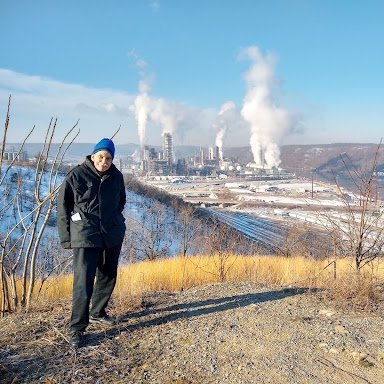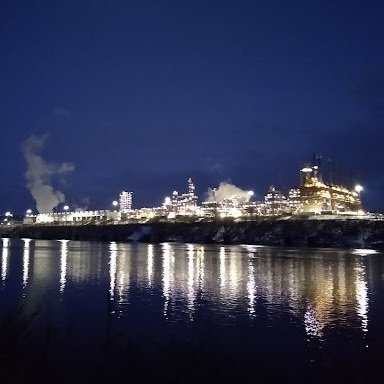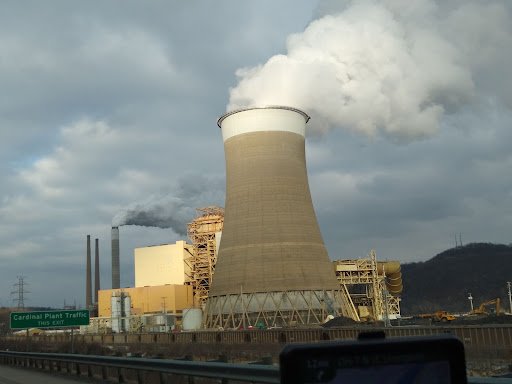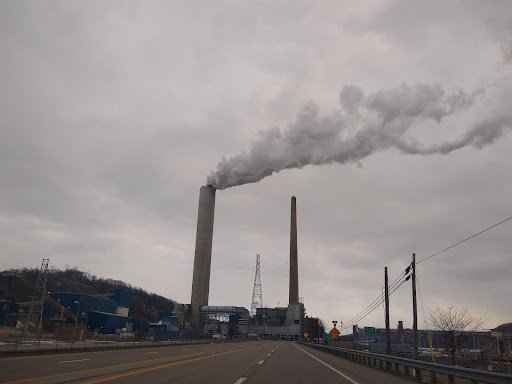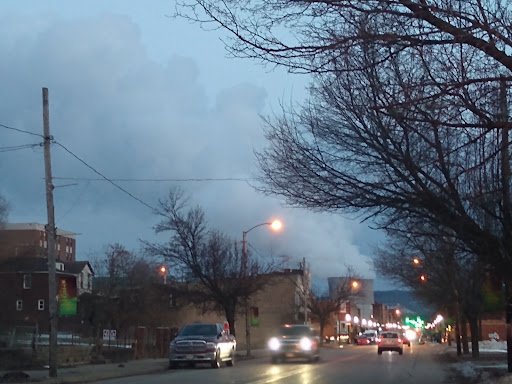☢️The Toxics Tour - A Trip Through the Ohio River Valley🛥️
Alexis Goldsmith out on the Ohio River with the Nurdle Patrol.
February 27, 2022
In the winter of 2022, Alexis Goldsmith, Beyond Plastics’ National Organizing Director, took a toxic tour through the Ohio River Valley.
The boom in hydraulic fracturing for natural gas (a.k.a. “fracking”) in this region has been driven an ongoing massive build-out of petrochemical infrastructure.
Alexis visited some of these facilities and met with a number of remarkably dedicated individuals and grassroots organizations who are working hard to hold the petrochemical industry accountable and prevent further build-out of oil, gas, and plastics infrastructure in this beautiful part of the country.
Read on to learn more about what she saw and learned in her travels as well as how you can find more information and connect with the organizations she met with to support their efforts.
PTT Global Chemical in Dilles Bottom, Ohio
Alexis stopped at the site of a proposed ethane cracker plant in Dilles Bottom, Ohio, where she met Jill Hunkler. Jill is a member of Concerned Ohio River Residents (CORR), a coalition of organizations and individuals that wants to move the regional economy away from petrochemicals.
Jill Hunkler of Concerned Ohio River Residents, photo by Alexis Goldsmith
It's been nearly a decade since PTT Global Chemical proposed an ethane cracker plant in Belmont County to produce plastic from fracked ethane gas. Jill, a 7th generation Ohio River Valley resident, says "fracking leads to cracking." Indeed, it appears that extraction of fracked gases, rather than consumer demand, is driving the build-out of plastic manufacturing in Appalachia: the American Chemistry Council projects fracking in the region could support five new ethane crackers.
At the start of the fracking boom, residents were promised generous royalties in exchange for signing leases allowing gas companies to frack their land. Now, Jill says hopes of economic prosperity have dried up, and what they've been left with is an environmental nightmare as fracking infrastructure continues to grow.
Since 2000, the number of fracking wells in the US has grown from 23,000 to more than 1.7 million. They come with pipelines, compressor stations, heavy trucks, railcars, barges, and injection wells to transport, process, and store the radioactive slurry of contaminated water, sand, and gas that comes out of them.
Fracking infrastructure includes ethane crackers like the one PTT Global Chemical proposes. To support the cracker, 1,000 new fracking wells would need to be drilled every 3-5 years, to produce roughly 2 million tons of new plastic each year. New ethane crackers perpetuate a toxic cycle of extraction, combustion, and waste. As one CORR organizer put it, “Fracking hasn’t been as bad as I’d thought… it’s much worse than I ever could have imagined.”
PTT Global Chemical has already bought hundreds of acres, demolished homes, and cleared land for the cracker. But a final investment decision has yet to be made, and in the meantime, their air permits have expired. The company intends to apply for new permits.
The land along the Ohio River is mostly bare earth. Jill says it should be used for hemp farming, solar arrays, and environmental education instead.
Austin Master in Martins Ferry, Ohio
This nondescript red facility is Austin Master, a company that processes radioactive wastes from oil and gas industries. It is located next to a high school and sits on top of the municipal aquifer.
The Austin Master facility. Photo by Alexis Goldsmith
Fracking generates large amounts of contaminated water that contains radioactive isotopes from the Earth’s crust, but radioactive waste generated by the fracking industry is largely unregulated thanks to the Bevill and Bentsen Amendments to the Resource Conservation and Recovery Act (RCRA).
CORR has been campaigning to move the regional economy away from fracking infrastructure, and says that the radioactive frack waste that goes to Austin Master is not regulated as it should be. Immediate concerns include inadequate monitoring and testing, but CORR would like to end the production of radioactive oil and gas waste in the first place.
The radioactive waste generated by fracking was reported on in the 2019 Rolling Stone article “America’s Radioactive Secret.” However, it has been known since at least the 1990’s that oil and gas waste is radioactive. In Alexis’ role at Beyond Plastics, she has worked to bring attention to fracking waste as a wastestream of plastic production.
Shell Ethane Cracker in Monaca, Pennsylvania
Shell's massive ethane cracker plant in Monaca, PA. Photo by Alexis Goldsmith.
On a frigid Valentine’s Day, Alexis met up with Nurdle Patrol, a coalition team of scientists and volunteers monitoring microplastics in the Ohio River near the Shell ethane cracker plant. They met at the public boat launch at 11 am in Monaca, Pennsylvania, about a mile from the plant.
It was so chilly, the cables on the boat’s engine kept freezing, but boat captain Evan was able to get the team safely onto the water. He also loaned Alexis an insulated snowsuit, which she was grateful for.
There was no mistaking the Shell cracker plant once the team was in sight. This facility occupies about 400 acres right on the Ohio River. The tall, thin towers on the right are the “cracking towers” where ethane is turned into polyethylene at high temperatures. The plant also has a co-located power plant that burns fracked gas as fuel.
To monitor microplastics in the river, Nurdle Patrol utilizes a scientific protocol. They place a special sieve in the water at intervals of ten minutes in different locations on the river, noting each location.
What they’re looking for are nurdles: small polyethylene microplastics that are produced in ethane crackers from ethane gas. From the crackers, nurdles are shipped to other facilities to be turned into products like plastic bags and soda bottles. Nurdles are like glitter — they spread easily, and tend to spill wherever they are transported.
After ten minutes, the contents of the sieve are rinsed through larger and then smaller filters made of hardware cloth. The large sticks are filtered out, and what remains are small debris including nurdles. On this day, the team found a few polystyrene nurdles - there is a polystyrene plant just upriver from the Shell Cracker.
Examining the debris that remains in the sieve. Photo by Alexis Goldsmith.
Nurdle Patrol is getting a baseline of microplastics in the river now in order to have data to compare once the plant is operational. The Shell ethane cracker is expected to begin operating by the end of 2022. The facility includes a barge dock and railyard for transporting nurdles from the plant. Once operational, the facility is projected to fill 100 rail cars a day with plastic nurdles.
After spending a few hours with Nurdle Patrol, Alexis met up with Dr. Clifford Lau, a local chemistry professor who is heading up a citizen air monitoring project called “Eyes on Shell.” Like nurdle patrol, Eyes on Shell is a coalition project of organizations and volunteers monitoring pollution from the Shell cracker, the first ethane cracker in Appalachia. The air monitoring effort is focusing on volatile organic compounds (VOC’s) and nitrogen oxides (NOx), a family of poisonous, highly reactive gases.
Alexis asked Dr. Lau why groups like Nurdle Patrol and Eyes on Shell are taking it upon themselves to monitor pollution from the Shell cracker, rather than leaving it up to the Pennsylvania Department of Environmental Protection (DEP). His short answer was that the defunding of the Pennsylvania DEP over many years has left the state agency without sufficient resources or staff resources to protect citizens and the environment.
Dr. Clifford Lau of Eyes On Shell and a view of Shell’s ethane cracker facility at night. Photos by Alexis Goldsmith.
What Does The Future Hold?
In the Ohio River Valley, Alexis saw fracking, plastic, and coal plants side by side, sharing the same infrastructure and making it clear that rather than being “the next” petrochemical corridor, this region is already a functioning petrochemical corridor. She also saw more fossil fuel facilities in construction than closed facilities, compounding pollution and running counter to the industry narrative that “fracked gas is a bridge fuel.”
This area has amazing people who love their valley and want to protect it. They are not helpless: they are scientists, leaders, students, and organizers. They are dedicated, but they also need healing, from the mental stress and pollution of being surrounded on all sides by petrochemical infrastructure.
There is also an opportunity to amplify issues in the Ohio River Valley. The topography of the area includes rolling hills and valleys, and the petrochemical facilities are essentially tucked away in rural areas, mostly out of view until you’re upon them. More could be done to organize in the metropolitan state capitals of Ohio, Pennsylvania, and West Virginia.
More Information
You may find the recording of our September 27, 2022 webinar on Petrochemicals, Public Health & informative.
Connect With Advocacy Groups In The Region
Eyes on Shell: https://www.marcellusawareness.org
Nurdle Patrol is a coalition effort led by organizations including Mountain Watershed Association, 3-Rivers Waterkeeper, and Youghiogheny Riverkeeper, and volunteers
Concerned Ohio River Residents: https://www.concernedohioriverresidents.org










